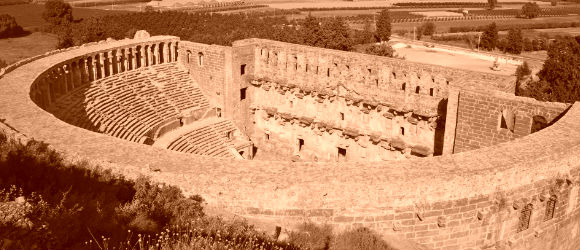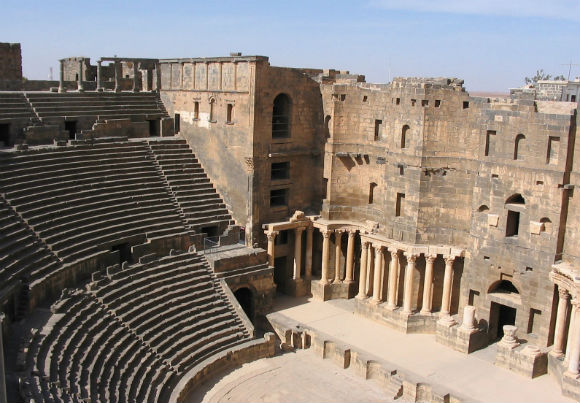Aspendos was an ancient Greco-Roman city in Antalya province of Turkey. It is located 7 kilometres (4.3 mi) northeast of central Serik.
Aspendos was an ancient city in Pamphylia, Asia Minor, located about 40 km east of the modern city of Antalya, Turkey. It was situated on the Eurymedon River about 16 km inland from the Mediterranean Sea; it shared a border with, and was hostile to, Side. According to later tradition, the (originally non-Greek) city was founded around 1000 BC by Greeks who may have come from Argos. The wide range of its coinage throughout the ancient world indicates that, in the 5th century BC, Aspendos had become the most important city in Pamphylia. At that time the Eurymedon River was navigable as far as Aspendos, and the city derived great wealth from a trade in salt, oil, and wool.
Aspendos did not play an important role in antiquity as a political force. Its political history during the colonization period corresponded to the currents of the Pamphylian region. Within this trend, after the colonial period, it remained for a time under Lycian hegemony. In 546 B.C. it came under Persian domination. The face that the city continued to mint coins in its own name, however, indicates that it had a great deal of freedom even under the Persians.
In 467 B.C. the statesman and military commander Cimon, and his fleet of 200 ships, destroyed the Persian navy based at the mouth of the river Eurymedon in a surprise attack. In order to crush to Persian land forces, he tricked the Persians by sending his best fighters to shore wearing the garments of the hostages he had seized earlier. When they saw these men, the Persians thought that they were compatriots freed by the enemy and arranged festivities in celebration. Taking advantage of this, Cimon landed and annihilated the Persians. Aspendos then became a member of the Attic-Delos Maritime league.
The Persians captured the city again in 411 B.C. and used it as a base. In 389 B.C. the commander of Athens, in an effort to regain some of the prestige that city had lost in the Peloponnesian Wars, anchored off the coast of Aspendos in an effort to secure its surrender. Hoping to avoid a new war, the people of Aspendos collected money among themselves and gave it to the commander, entreating him to retreat without causing any damage. Even though he took the money, he had his men trample all the crops in the fields. Enraged, the Aspendians stabbed and killed the Athenian commander in his tent.
When Alexander the Great marched into Aspendos in 333 B.C. after capturing Perge, the citizens sent envoys to him to request that he would not establish that he be given the taxes and horses that they had formerly paid as tribute to the Persian king. After reaching this agreement. Alexander went to Side, leaving a garrison there on the city’s surrender. Going back through Sillyon, he learned that the Aspendians had failed to ratify the agreement their envoys had proposed and were preparing to defend themselves. Alexander marched to the city immediately. When they saw Alexander returning with his troops, the Aspendians, who had retreated to their acropolis, again sent envoys to sue for peace. This time, however, they had to agree to very harsh terms; a Macedonian garrison would remain in the city and 100 gold talents as well as 4.000 horses would be given in tax annually.
In 190 BC the city surrendered to the Romans, who later pillaged it of its artistic treasures. Toward the end of the Roman period the city began a decline that continued throughout Byzantine times.
Aspendos,



Don't miss the short climb up 'theatre hill' to look down into the amphitheatre, quite spectacular. Elsewhere in the site there is a lovely view of the aqueduct, which we drove to after this visit for a closer inspection. Good footwear is advisable as some of the ground is a little rough, also take plenty of water to drink. Inside…
This is an excellent chance to get a feel for a real Roman theatre – not a gladiator pit or a colleseum but an ancient cultural venue. It was designed to have great accuostics and it still does, being used right to the present for stage performances. Do climb up to the top of the seating and listen to the…
This was well worth a visit. We had the service of a tour guide who really brought the visit to life. He gave very good, clear explanations of the history of the place.
Many photo opportunities here. See how a Roman theater actually looked and walk all around in it. Some of the original friezes and statues are in the Antalya Museum. Visited Nov. 2007.
Amazing to see so much history so well preserved. Maybe not interesting to smaller children although there are photograph opportunities with gladiators.
Visited site on afternoon from Belek by rental car. Worth taking good shoes and also walking around the hill behind the theatre. Allow a couple of hours for your visit. The theatre is also used for operas in June & July and worth looking out for adverts. Aida was being performed shortly after our visit.
We came here on a mildy warm day at the end of november. For 15TL per person you can walk around magnificent sights. With a bit of a walk over a rocky path you can come to a bassilica with breathtaking views of the valley around. Around 0:50pm the mosks around the valley simultaniously started echoing sound trough the air….
The almost-complete ancient structure gives very clear understanding of the beautiful visibility and acoustics. The stage is impressive, as are the backstage spaces and the exit stairways and ramps. Several actors in Roman gladiator costumes completed the impact!
So much to look at! Wish we could have spent more time, but it was extremely hot out and kids were worn out. Recommend sneakers for climbing on rocks and up hills and bring lots of water on hot days. Beautiful views and incredibly preserved amphitheater.
I was in Italy before, and I have to say, in Italy i did not find a so nice and big theatre like this. For history students it is a must see thing.